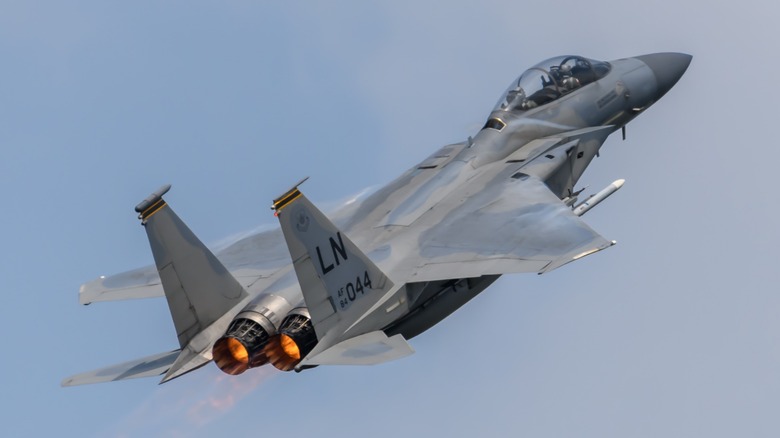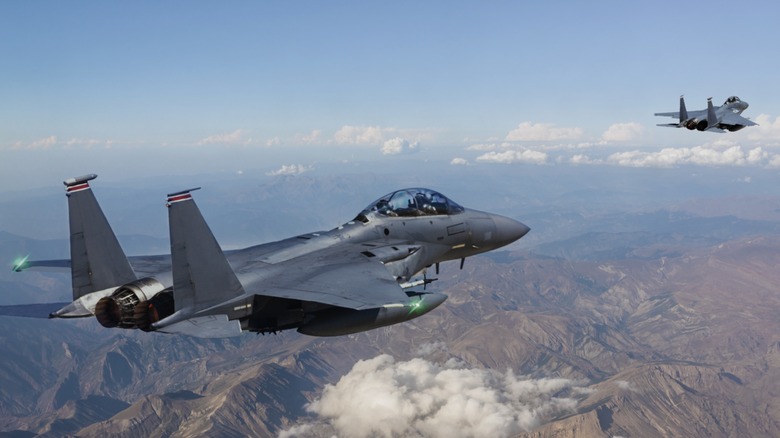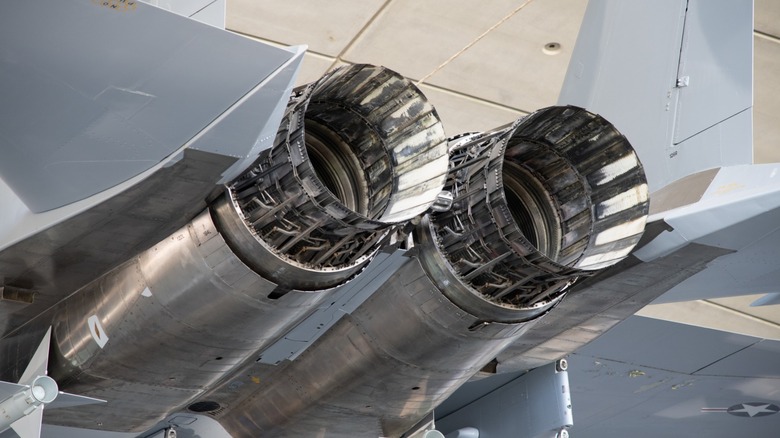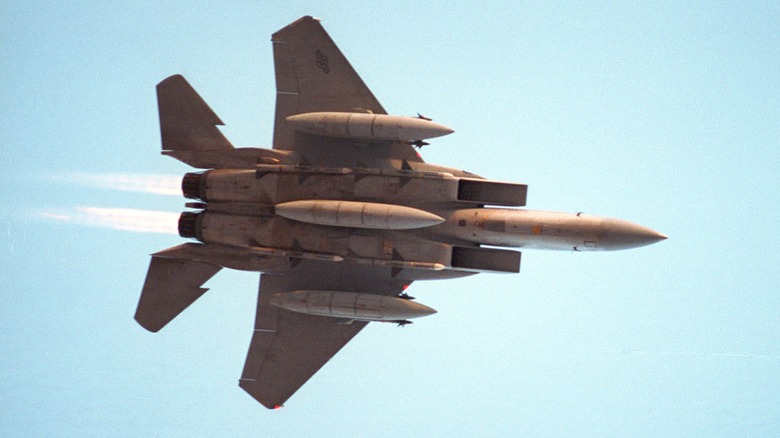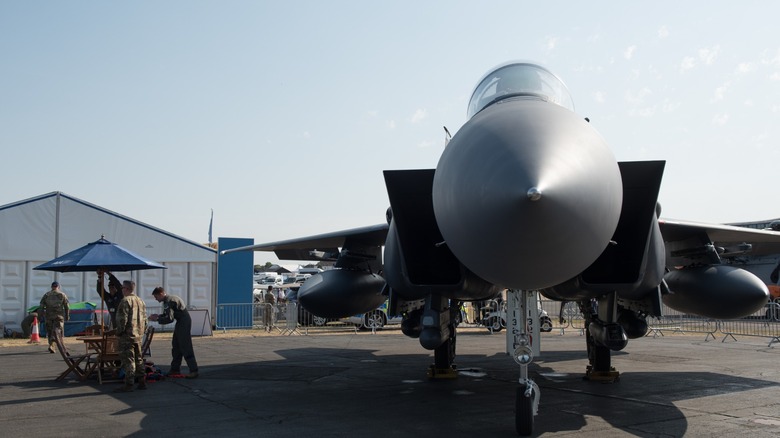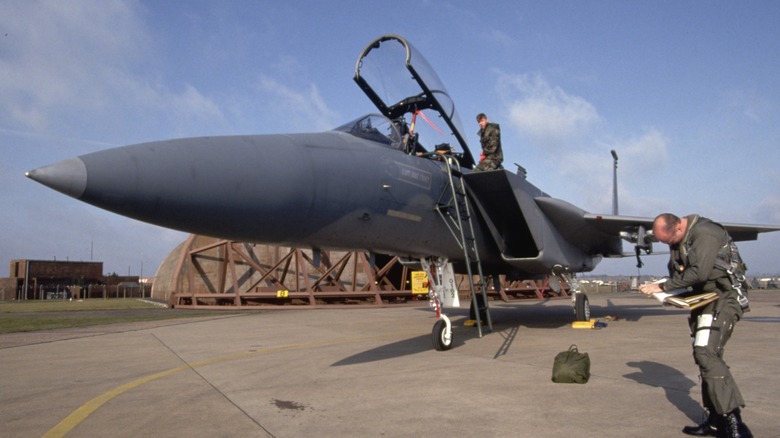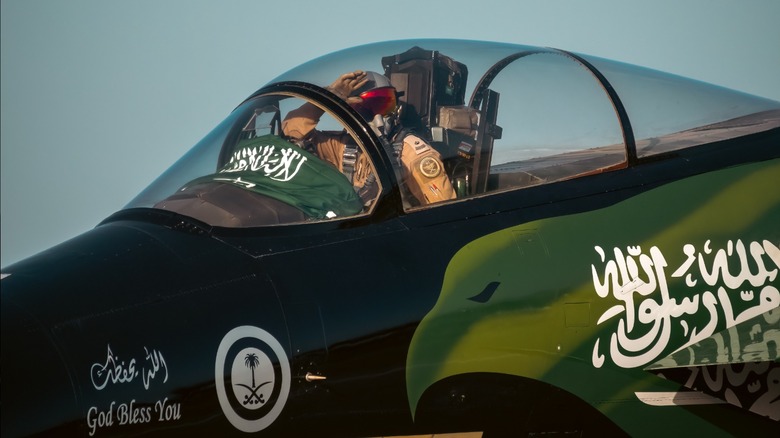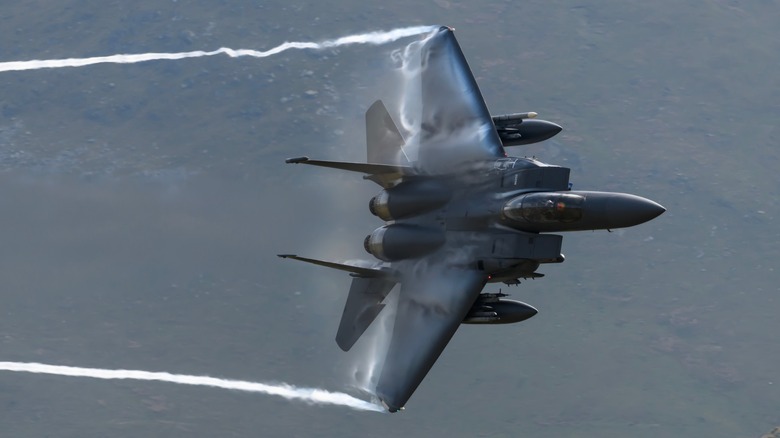What Made The F-15 Eagle Jet A Legend Of The Skies
While the modern Lockheed Martin F-35 Lightning II is a highly praised and highly publicized advanced American fighter jet worthy of attention, it is but one arrow in the quiver of American military airpower. The most current fighter jets are built upon a long history of cutting-edge development of powerful and agile military aircraft built by the best and brightest engineers and designers in the world.
The armed services and the aircraft contractors have set many benchmarks through many generations of warplanes and fighter jets over a long and proud history with numerous examples that could stand out in a crowd. One of those that has earned the right to be held on a pedestal and honored by the men and women who fly and maintain it is the venerable F-15 Eagle from McDonnell Douglas.
Though the F-15 is not the newest aircraft in the American fleet, it is still one of the best. The flexibility of the platform, combined with its extreme performance, makes it one of the most versatile and capable aircraft Americans have at their disposal. Sometimes known as the aircraft equivalent of a muscle car, the F-15 possesses the ability to take off at speed and then, unlike a muscle car, turn on a dime. Today's most advanced fighters equipped with electronic warfare and built-in stealth technology are some of the most capable weapons available today, and they present as formidable foes to our adversaries. However, the F-15 still has a place in the modern American military — here is what made it a legend of the skies.
Development history
The 1960s was an intense time for geopolitics. While civil conflicts, overthrows, and revolutions plagued countries around the globe, the United States and Soviet Union's horns were locked, with one waiting for the other to blink. Most of the battles the two countries engaged in were acts of technological brinkmanship, with one introducing an ever-increasingly capable design to outperform the other, only to be rebutted by an even more advanced design. Fighter jets were at the forefront of this cat-and-mouse game, and new fighter jets were always in development to outperform one another.
The conflict in Vietnam spurred a concerted effort to create faster and more maneuverable aircraft to stem the tide of aerial losses, which were being lost at an alarming rate to North Vietnam's Soviet-built MiG-21s. However, while early designs were being hashed out for the program, top brass became aware of the new MiG-25 Foxbat. This new plane was thought to be an even graver risk to American pilots, and plans for a new fighter accelerated. The MiG-25 had a huge airframe with powerful engines, twin vertical stabilizers, and a speed estimated to exceed Mach 2.0, so the new jet had to be agile and fast.
McDonnell Douglas won the contract for the new aircraft in 1969 with an order for 20 units. Flights began in 1972 in a new twin-engine single or double-seat jet with fixed delta wings and vertical stabilizers. Testing was successful, and the first production aircraft went into service in 1974, eventually replacing much of the aging F-4 Phantoms in inventory.
Airframe specifications
The F-15 has been built over many years in successive generations, representing updated models. The first of them was the F-15A/B, followed by the F-15C/D and the final F-15E Strike Eagle, which went into production in 1988. Although this aircraft has been produced over many years and has seen many technological and mechanical updates and upgrades, the airframe has remained a consistent design throughout. It stands about 64 feet long with a wingspan of 43 feet, with the pilots sitting nearly 19 feet from the ground. Its unfueled weight is 31,700 pounds, but it holds up to 36,200 pounds of fuel at capacity. The maximum takeoff weight of 68,000 pounds leaves room for plenty of weapons stored below.
Originally powering the Eagle was a pair of Pratt and Whitney F100-P-220 turbofans producing 23,450 pounds of thrust each. These give the jet a range of up to 2,173 nautical miles with external fuel tanks and a service ceiling of 65,000 feet. But the most impressive thing they do for it is push the aircraft up to a maximum speed of 1,875 mph, or Mach 2.5. It is the fastest fighter jet ever put into service by the American military and remains so today — the SR-71 Blackbird was faster, but it was a reconnaissance jet. Furthermore, the F-15 was the first fighter jet to accelerate vertically immediately after takeoff.
The F-15A introduced an innovative head-up display along with advanced avionics, radar, and inertial navigation systems. These systems have been upgraded over the years, keeping the F-15 as capable and competitive as ever.
Armament
While the F-15 is a pretty thing to look at, and its impressive speed and agility can put us in awe of it, it is a fighter jet with military purposes first and foremost. Therefore, it needs to have weapons. Of course, the American military would never send its pilots unprepared, meaning the F-15 Eagle is equipped to bring the pain.
Speaking of the F-15E Strike Eagle, the latest and most advanced version, a wide range of weapons can be carried. For the extremely rare dogfight, pilots have an internal 20mm multi-barrel gun with 500 rounds of ammunition. However, modern conflicts rarely see such engagement, and that's because of the other weapons. For the Strike Eagle, this includes up to eight missiles installed on its hardpoints. These are guided air-to-air weapons using advanced guidance systems that make them deadly accurate.
Additionally, the Strike Eagle can carry air-to-surface weapons, either conventional or nuclear, including the GBU-15. This is a glide bomb with real-time guidance that can be directed while en route to a target to ensure pinpoint accuracy. It can be guided automatically or by a pilot in the F-15E and F-111F Nighthawk. With the retirement of the F-111F, it is now exclusive to the F-15.
Service history
Squadrons of F-15s began to be formed after its introduction in the '70s but saw little to no action for many years. The first major engagement by an F-15 occurred in Iraq during Desert Storm. In combat, the F-15 has proven to be incredibly capable, with not a single aircraft lost due to combat — the only losses of aircraft have been due to accidents. However, F-15 pilots have confirmed 104 kills since its introduction. Since 1991, F-15s have been an integral part of aerial operations.
During Operation Desert Shield in Iraq, coalition forces scored 44 air-to-air victories over Iraqi forces. Of those engagements, 40 of them were completed in a version of the F-15. In 1999, during NATO operations over Kosovo, Captain Jeff "Claw" Hwang piloted his F-15C when he encountered a pair of MiG-29 Fulcrums, shooting both of them down with AIM-120 missiles, receiving the Distinguished Flying Cross for his service.
Operation Enduring Freedom began in 2001 with the invasion of Afghanistan and, later, Iraq. F-15s played a significant role in all operations, including two flying daily missions, as they were the only aircraft equipped to handle the 5,000-pound bunker buster bombs or AGM-130 guided missiles. Also, during Israeli training exercises over the Negev desert in 1983, an aerial accident led to the wing of an F-15 being ripped off from a mid-air collision. Incredibly, the two pilots flying the aircraft, unaware of the extent of the damage, managed to get it back to base and land with only one wing remaining.
Current service
Military aircraft designed more than 50 years ago are often no longer useful or have been superseded by modern and more capable designs. Yet, the F-15 still flies and is still being manufactured — Boeing has taken over production following a merger with McDonnell Douglas. The F-15E Strike Eagle is the most up-to-date version and flies with the latest in avionics and enhanced targeting systems. However, F-15C/D aircraft are still in service; the last F-15A was retired in 2009.
Plans are underway to retire a large portion of active F-15 aircraft. The USAF maintains about 200 F-15s — it wants to retire 57 F-15C/D and 119 older F-15E platforms. However, Congress recently limited the number of F-15E to be retired to just 68. All of this is part of an effort to modernize and update the fleet throughout the armed services.
While the USAF will keep some of its newer F-15E aircraft in service, its plans are not simply to fly these until they are used up. An even newer version called the F-15EX Eagle II is on the horizon. It will be equipped with many enhancements, including the Open Mission System (OMS), designed to be easily upgraded with future updates and helmet-mounted situational awareness displays.
The process of acquiring the new models is underway. Delivery of the first batch has been delayed, but they are expected to be in service sometime in 2024. This means the F-15 will be flying for years to come.
Foreign users
Export versions of military aircraft have long been a part of the American defense industry tradition. The Department of Defense claims that these arrangements with allies and regional partners bolster security worldwide and aid with diplomatic efforts. Furthermore, the private companies that build the equipment aren't likely to turn down additional profits. Therefore, the F-15 was built from the start with exports in mind and has since gone on to serve several nations.
The first F-15 exports went to Israel in 1976. They have been used in many operations since then, including the landing with one wing incident, and continue to keep them in service today. Japan's self-defense forces acquired F-15s in the late '70s. Shortly after putting them into service, Mitsubishi became a primary contractor producing a Japanese version of the aircraft dubbed the F-15J/DJ. Saudi Arabia received F-15s for the Royal Saudi Arabia Air Force in the '80s, downing two Iraqi Mirage F-1s as a part of Desert Storm.
In 2005, South Korea received a version of the Strike Eagle dubbed the F-15K Slam Eagle, building up a fleet of about 60 aircraft in total. At the same time, Singapore acquired a dozen F-15SG aircraft, with eight more purchased a couple of years later. Boeing's production facilities for the F-15 in Missouri had been at risk of closure until Qatar placed an order for up to 72 F-15s. Despite protests by Israel, Qatar eventually received its F-15QA Ababil aircraft in 2017. This is what spurred the USAF to revive the platform for its upcoming F-15EX Eagle II.
F-15's future
While some aircraft remain flying much longer than expected, such as the B-52 Stratofortress, most do not continue flying or being built for decades on end. The F-14 Tomcat, for example, entered service at about the same time, but the last aircraft was retired in 2006. However, the F-15, introduced in the '70s, has seen several versions with upgrades to nearly every system to update and better equip them for an ever-changing battlefield. Even with stealth fighters, which it is not, the F-15 remains relevant to the readiness of today's modern military.
The latest version, the upcoming F-15EX Eagle II, will have the latest technology throughout. Among the advanced features are fly-by-wire flight controls, electronic warfare capabilities, and a pair of General Electric F110-GE-129 engines, providing 29,000 pounds of thrust each, an increase of 7,000 pounds over the F-15A. The radar will allow pilots to track multiple targets simultaneously with precision. Pilots will also wear Joint Helmet Mounted Cueing System II (JHMCS II), giving them complete situational awareness directly to the visor of their helmets. Boeing has also created a Silent Eagle incorporating stealth technologies into the airframe, many of which likely made it into the F-15EX.
In a world with stealth fighters snapping up the headlines and orders pouring in for foreign partners, there is still room for a capable fourth-generation fighter. Lower operation and acquisition make it ideal for situations in which stealth is not the greatest tactical advantage. In these scenarios, the F-15 will do, and that means the legend of the F-15 will be here to fight another day.
